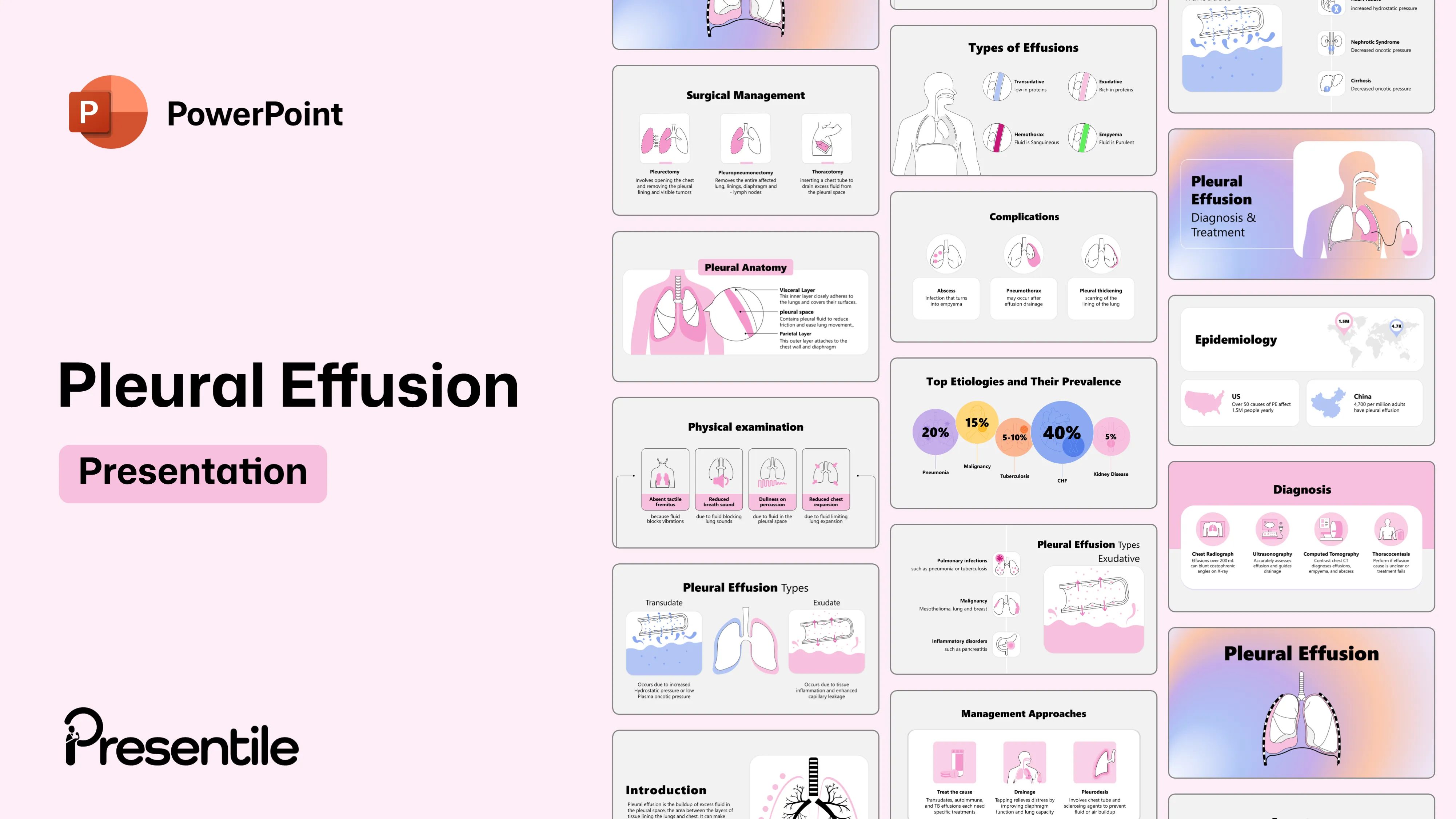
Content of
Pleural Effusion Presentation
Slide 1: Pleural Effusion - Title Slide

- This title slide provides a striking and professional introduction to the topic of Pleural Effusion.
- You can use this slide to immediately capture your audience's attention with a clean, compelling design that features a detailed anatomical illustration of fluid buildup around the lungs.
- This visual clarity allows you to set a professional tone and prepare your audience for a focused and insightful presentation right from the start.
Slide 2: Pleural Anatomy
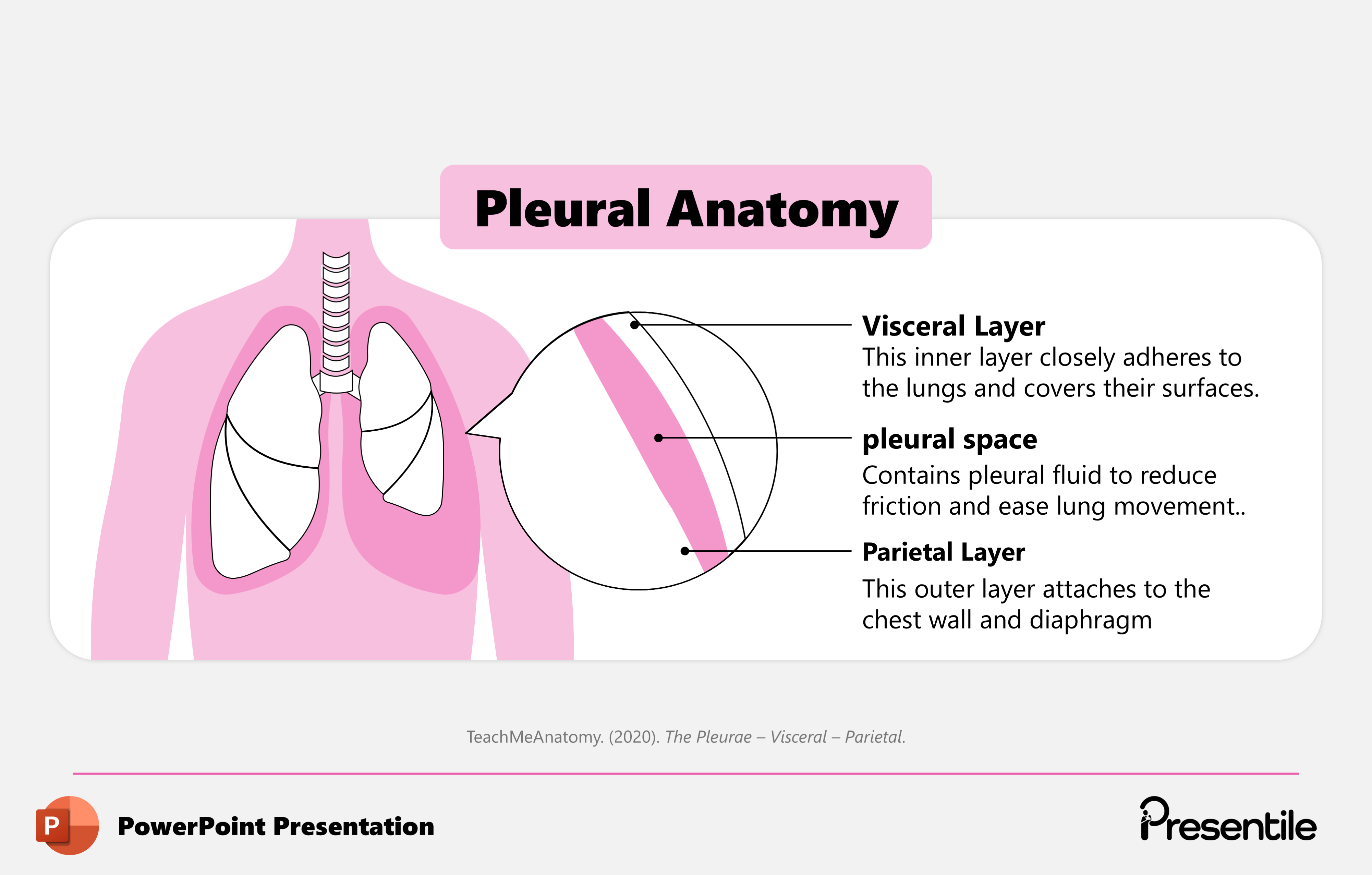
- This slide provides a clear and detailed anatomical overview of the pleura.
- You can use this fundamental slide to establish a foundational understanding for your audience, clearly differentiating between the Visceral and Parietal layers and highlighting the function of the pleural space.
- The professional diagram simplifies this complex anatomical concept, making it easy to understand how this crucial space facilitates smooth lung movement and how its disruption leads to the condition of pleural effusion.
Slide 3: Introduction to Pleural Effusion
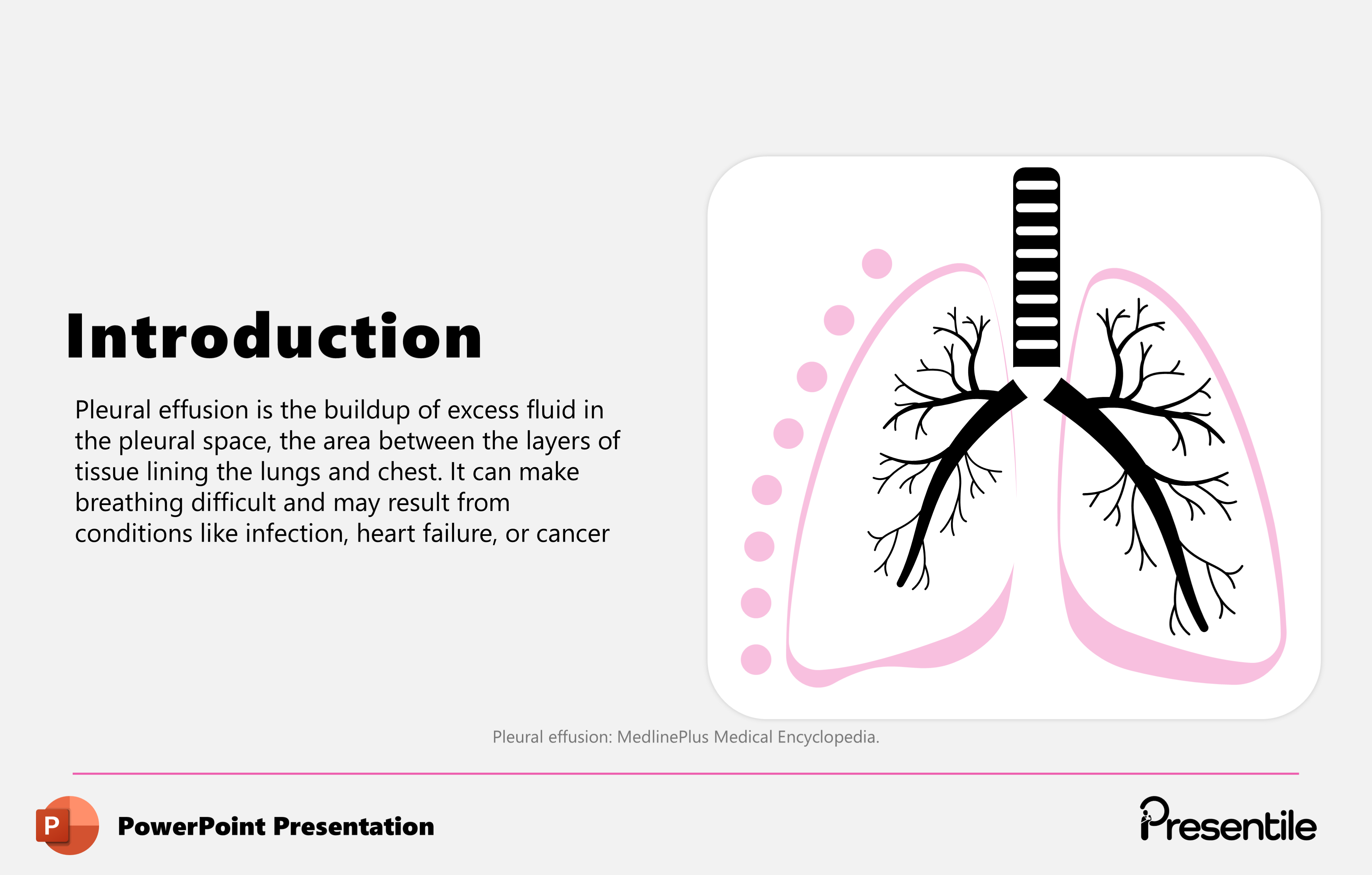
- This slide provides a clear and concise introduction to pleural effusion.
- It defines the condition as the buildup of excess fluid in the pleural space, explaining how this can lead to breathing difficulties.
- The slide also outlines the common underlying causes, such as infection, heart failure, or cancer.
- You can use this slide to clearly define the core concept for your audience and set the stage for a more detailed discussion of its causes and management.
Slide 4: Epidemiology & Global Impact
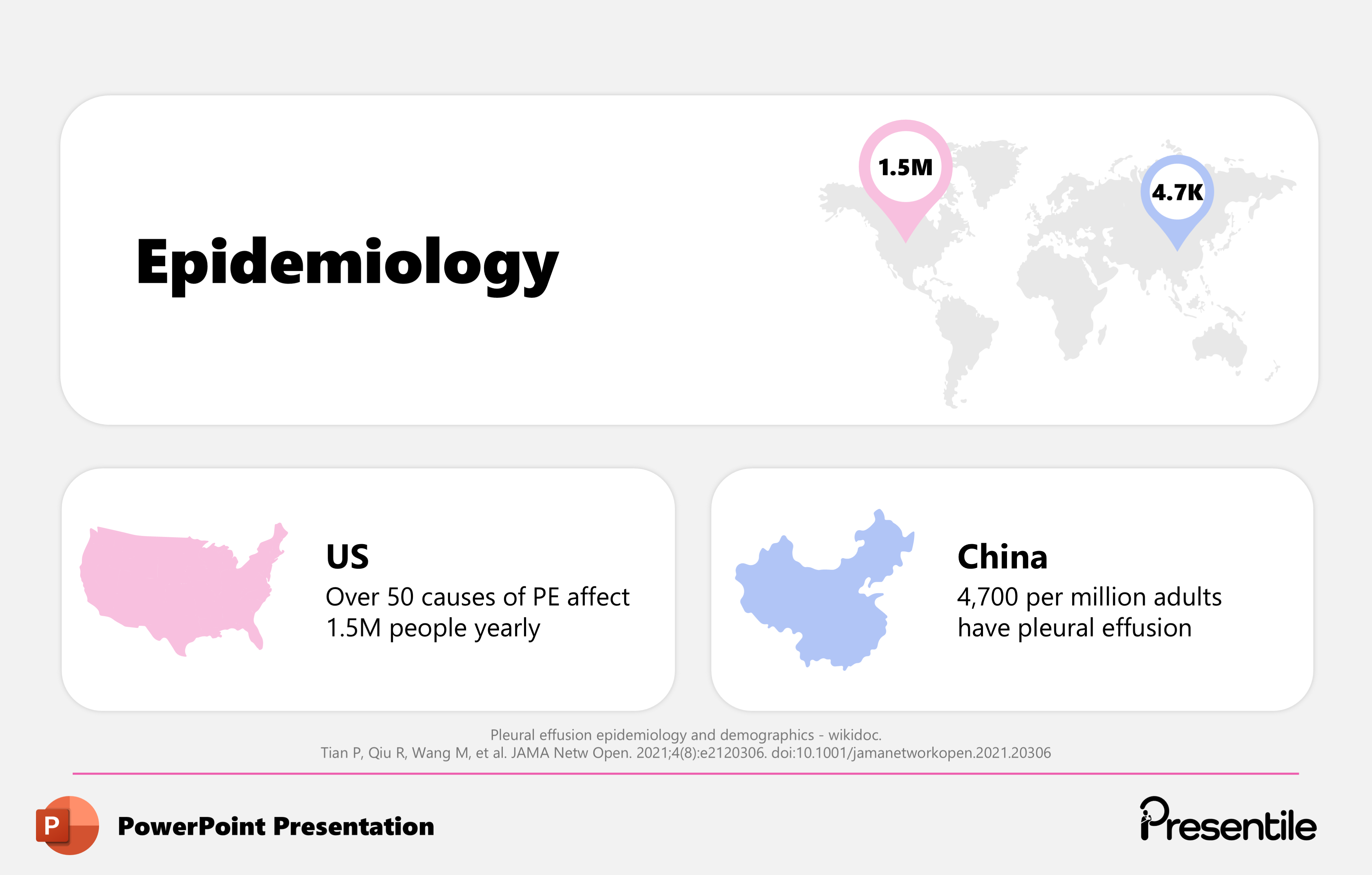
- This slide provides a compelling look at the global epidemiology of pleural effusion.
- By featuring specific data points for the US and China, you can immediately demonstrate the widespread impact of this condition, with 1.5 million people affected yearly in the US alone.
- This data-driven approach strengthens your presentation, giving your audience a clear and powerful sense of the scale and public health significance of pleural effusion.
Slide 5: Top Causes of Pleural Effusion

- This slide provides a powerful, visual breakdown of the top etiologies and their prevalence.
- You can use this clear infographic to quickly educate your audience on the primary causes of the condition, prominently featuring Congestive Heart Failure (CHF) as the most common cause at 40%.
- The concise presentation of key percentages for pneumonia, malignancy, tuberculosis, and kidney disease makes this slide an essential clinical tool for understanding the most likely underlying causes.
Slide 6: Classifying Pleural Effusions
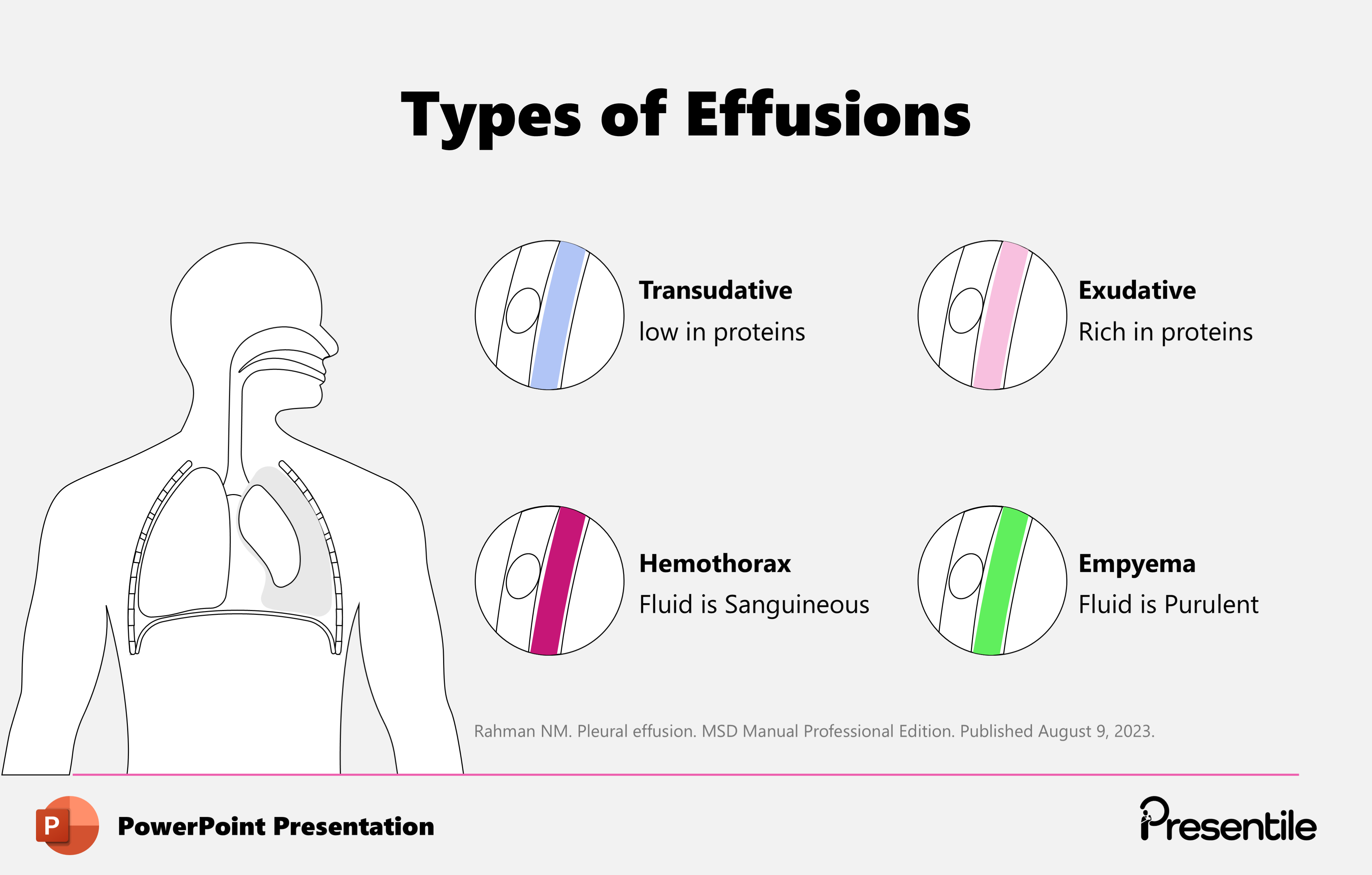
- This slide provides a clear and professional breakdown of the different types of pleural effusions.
- You can use this easy-to-read diagram to educate your audience on the crucial distinction between Transudative (low protein) and Exudative (high protein) effusions.
- The slide also clearly defines Hemothorax (sanguineous fluid) and Empyema (purulent fluid), providing a powerful, visual tool for understanding the diagnostic categories that guide clinical decisions.
Slide 7: Transudate vs. Exudate Effusions
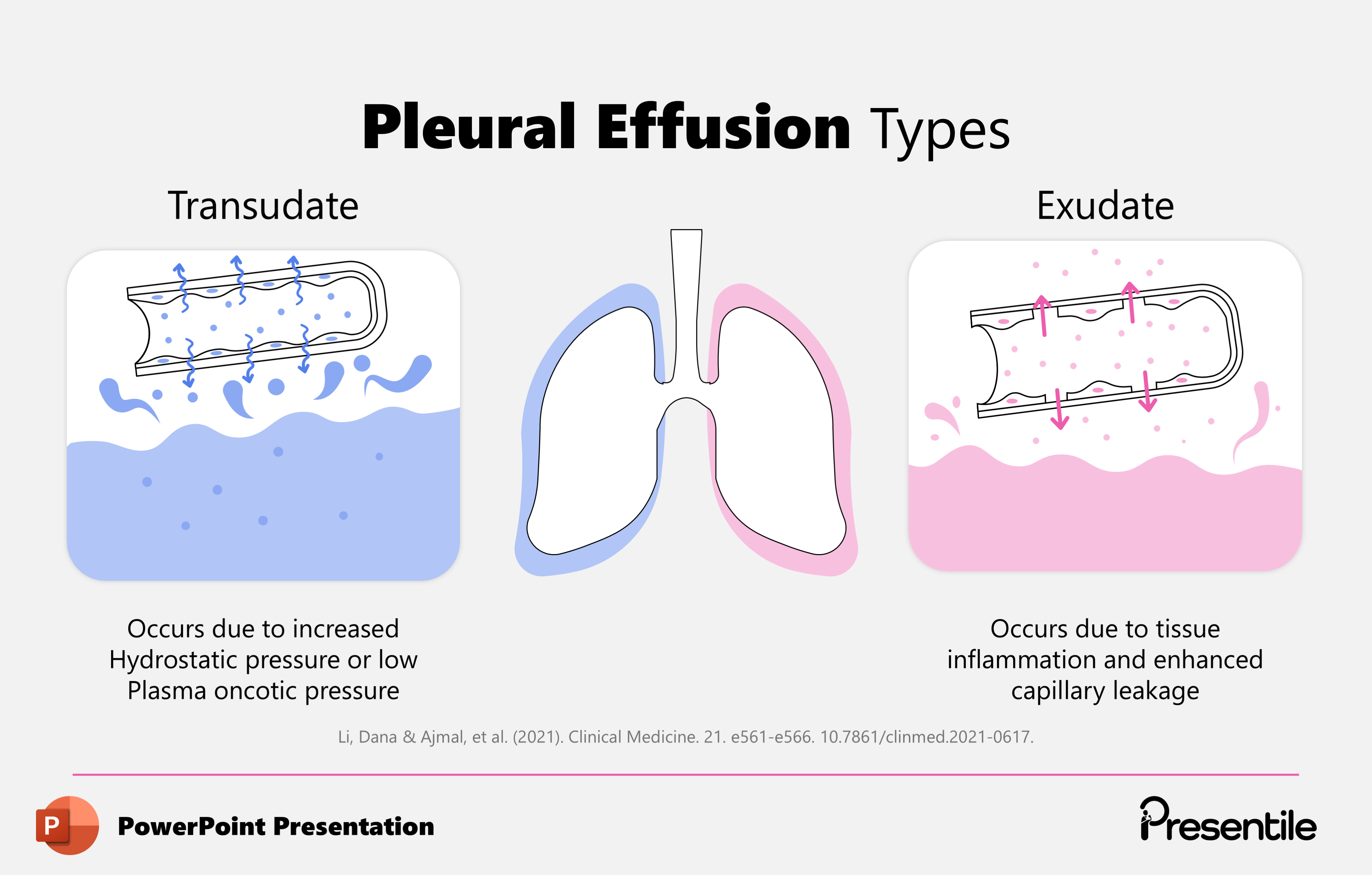
- This slide provides a powerful, side-by-side comparison of the two main types of pleural effusions.
- You can use this clear diagram to explain the critical difference between a Transudate effusion, caused by pressure imbalances, and an Exudate effusion, resulting from inflammation and capillary leakage.
- This visual explanation simplifies the underlying pathology, giving your audience a foundational understanding of the mechanisms that dictate diagnosis and treatment.
Slide 8: Causes of Transudate Effusions
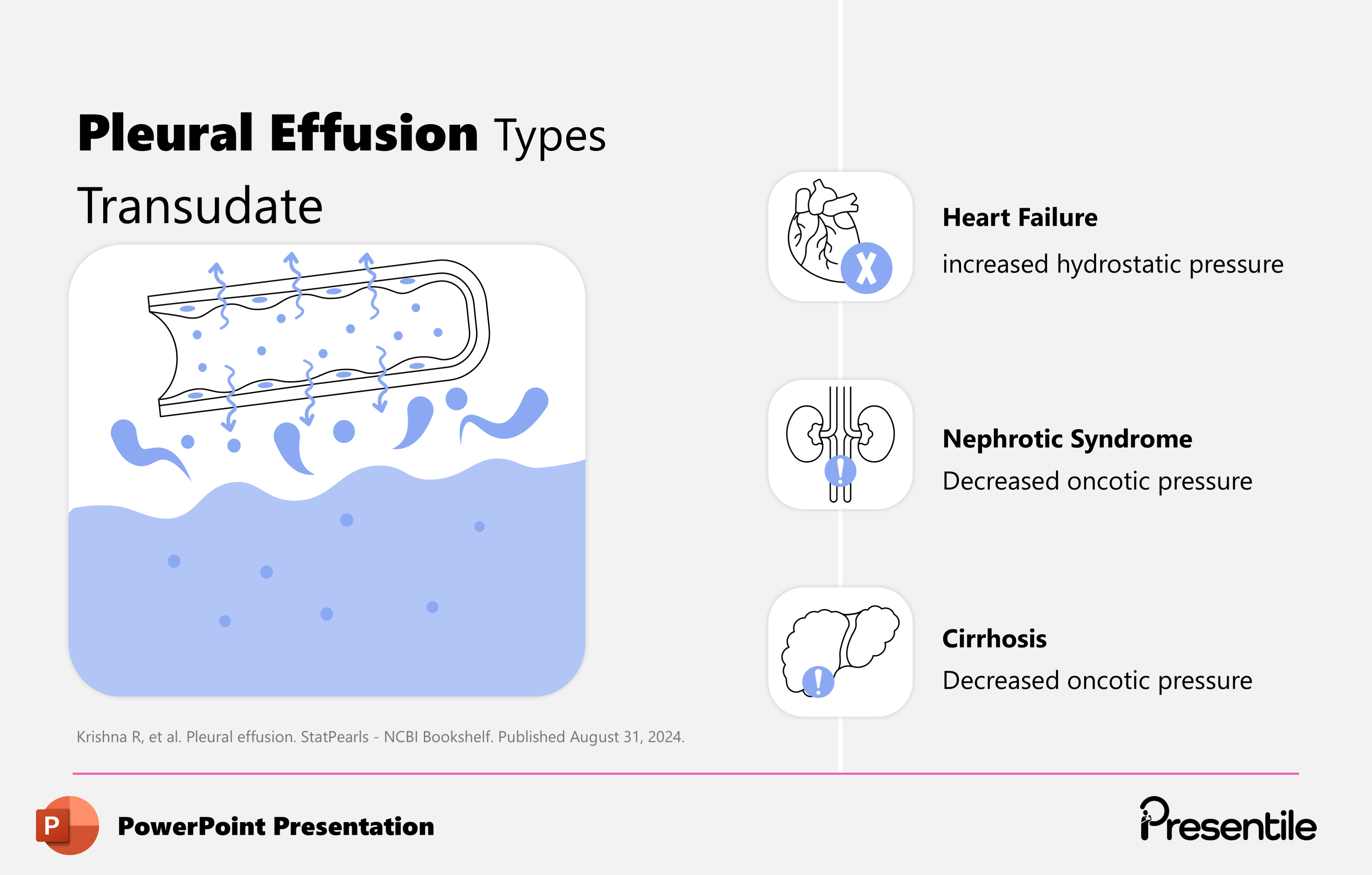
- This slide provides a focused breakdown of the common conditions that lead to a Transudate effusion.
- You can use this clear visual guide to explain how issues like Heart Failure (increased hydrostatic pressure), Nephrotic Syndrome, and Cirrhosis (both causing decreased oncotic pressure) create the fluid buildup.
- This slide connects the underlying organ pathology directly to the resulting effusion, simplifying a complex medical concept and providing a valuable clinical reference.
Slide 9: Causes of Exudative Effusions

- This slide provides a focused breakdown of the major conditions that cause an Exudative effusion.
- You can use this clear visual guide to explain how fluid buildup results from inflammation and enhanced capillary leakage, highlighting key causes like Pulmonary infections (pneumonia, tuberculosis), Malignancy, and Inflammatory disorders such as pancreatitis.
- The professional design simplifies complex pathology, making it an essential educational tool for understanding the most common inflammatory causes of pleural effusion.
Slide 10: Clinical Symptoms of Plural Effusion
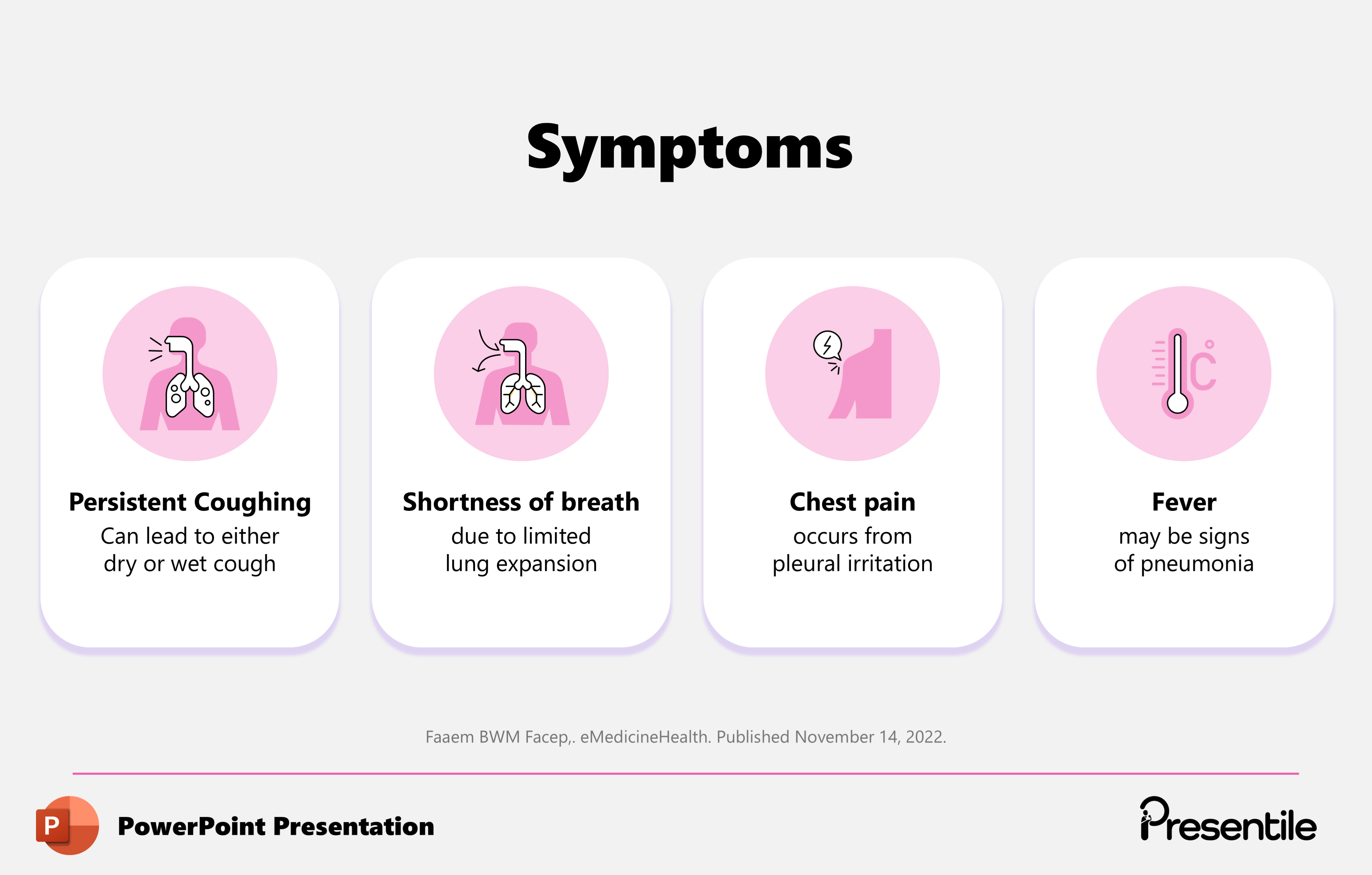
- This slide provides a clear and concise overview of the clinical symptoms of pleural effusion.
- You can use this organized, card-based layout to explain the key signs, including persistent coughing, shortness of breath, chest pain, and fever.
- The slide also provides a brief explanation for each symptom, connecting them to underlying causes like limited lung expansion and pleural irritation, making it an excellent resource for quick reference and effective education.
Slide 11: Potential Complications

- This slide provides a clear and concise overview of the potential complications of pleural effusion.
- You can use this critical summary to educate your audience on a range of risks, from the development of an Abscess to a Pneumothorax following drainage.
- The slide also highlights Pleural Thickening, a potential long-term complication, providing a thorough and practical look at the adverse outcomes associated with the condition.
Slide 12: Section Slide: Diagnosis & Treatment
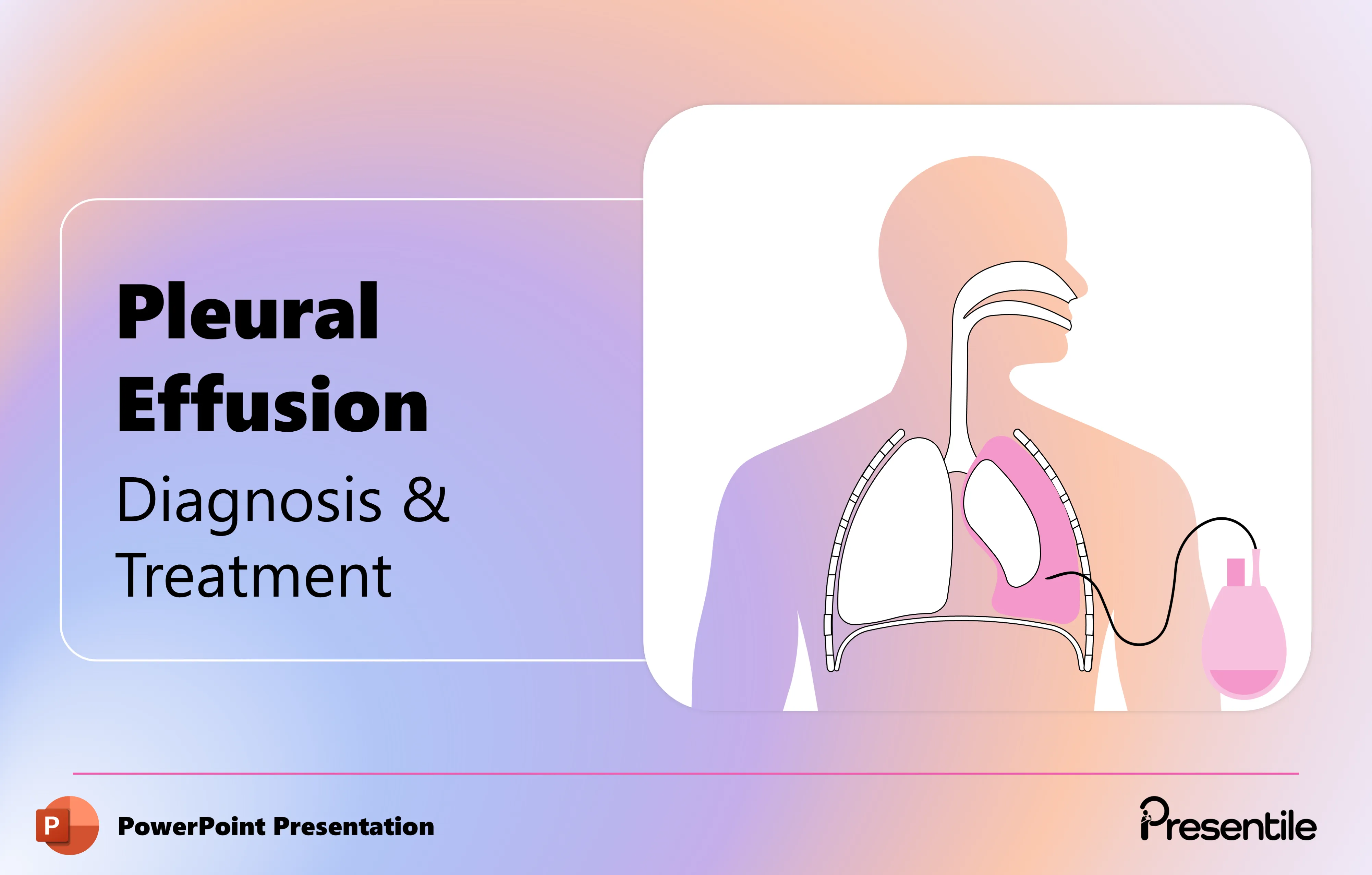
- This slide serves as a crucial section divider, signaling a major transition in the presentation to focus on the diagnosis and treatment of pleural effusion.
- Featuring a powerful visual that hints at treatment, you can use this slide to professionally guide your audience from understanding the condition itself to learning the practical, clinical steps of its identification and management.
Slide 13: Diagnostic Tools for Pleural Effusion
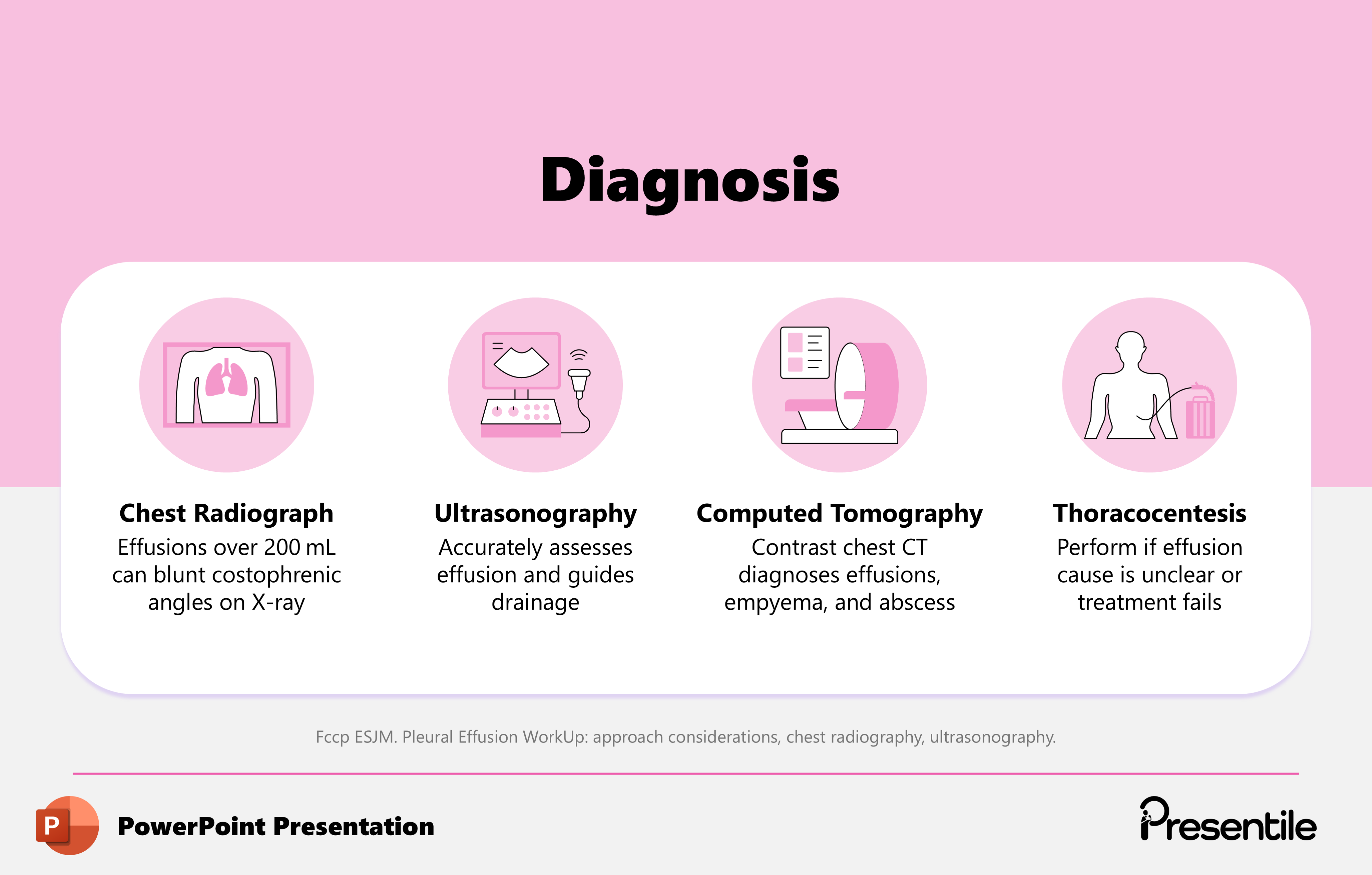
- This slide provides a clear and organized overview of the key diagnostic tools for pleural effusion.
- You can use this practical guide to explain how different medical imaging and procedures are used to identify the condition.
- The slide clearly details the use of Chest Radiographs, Ultrasonography (which can also guide drainage), Computed Tomography (for diagnosing complex cases), and Thoracocentesis (for both diagnosis and treatment).
Slide 14: Physical Examination Findings
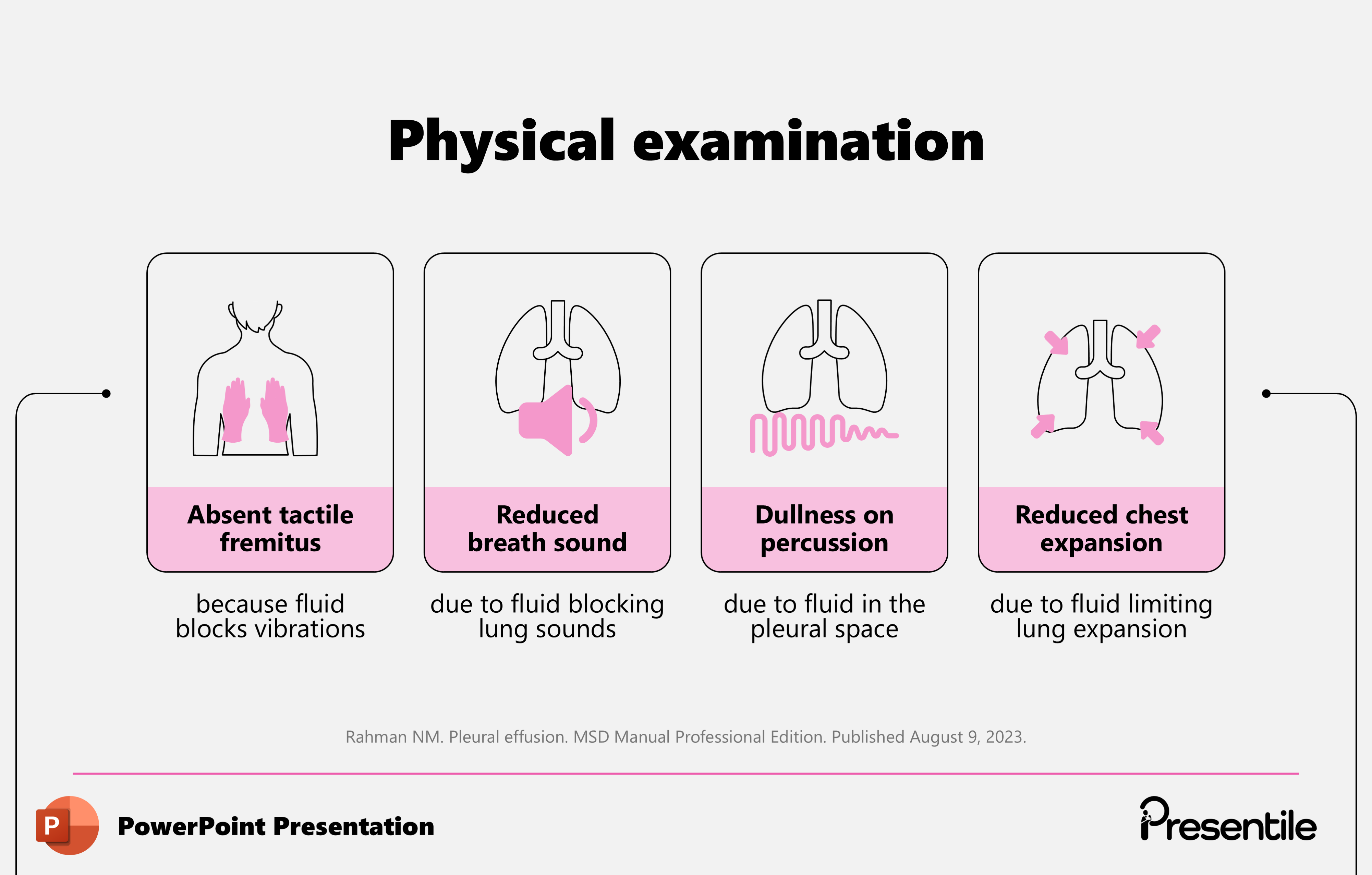
- This slide provides a clear and concise overview of the key physical examination findings for pleural effusion.
- You can use this practical guide to explain how fluid buildup impacts a patient's physical signs, detailing and visually demonstrating absent tactile fremitus, reduced breath sounds, dullness on percussion, and reduced chest expansion.
- This professional visual is an excellent tool for teaching clinical skills and diagnostic reasoning.
Slide 15: X-ray Findings
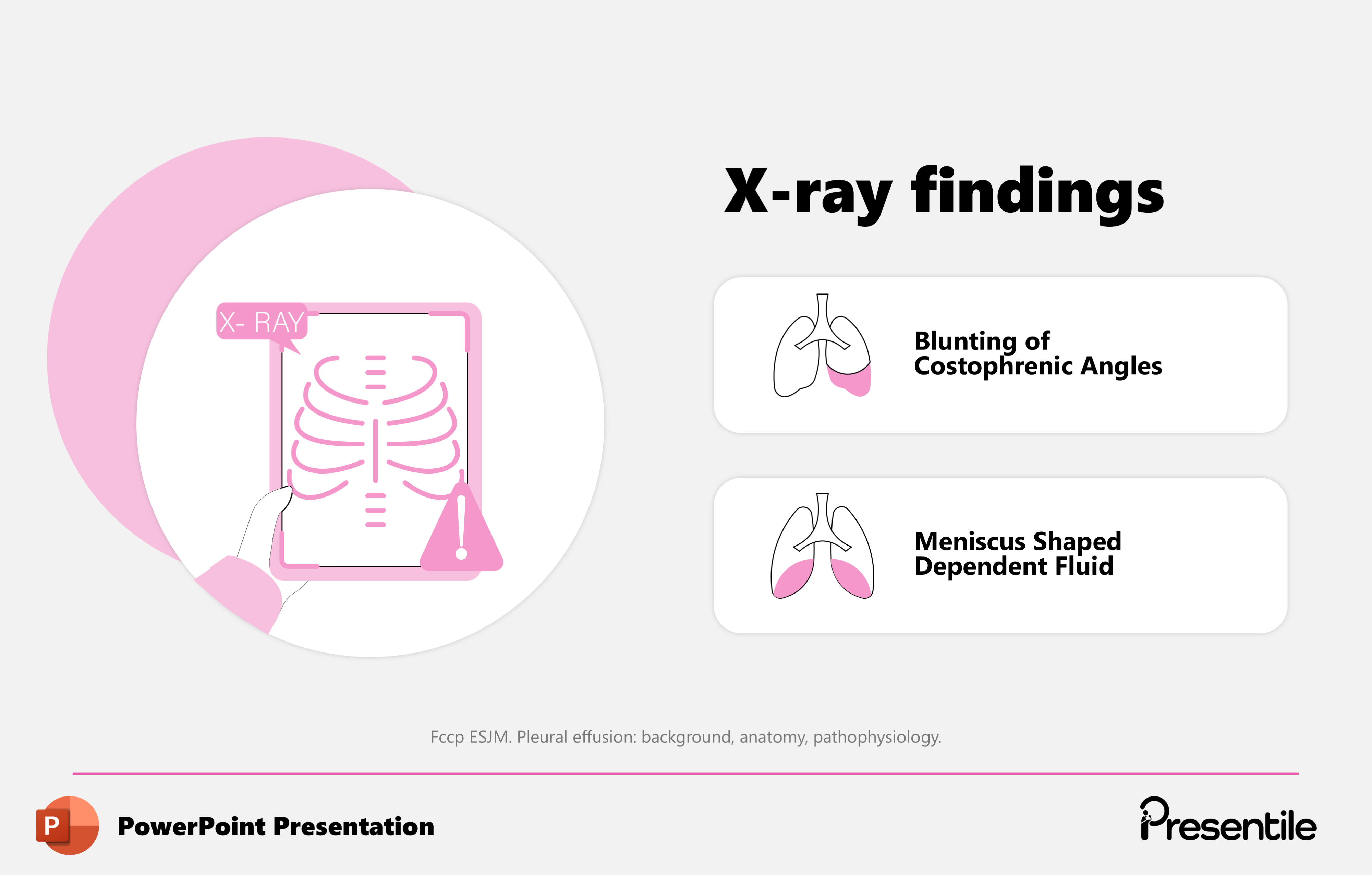
- This slide provides a clear visual guide to the key x-ray findings of pleural effusion.
- It highlights two critical signs: the blunting of costophrenic angles and the presence of meniscus-shaped dependent fluid.
- By visually connecting these findings to a professional x-ray illustration, you can provide your audience with the essential knowledge needed to interpret imaging results, solidifying their understanding of how pleural effusion is diagnosed.
Slide 16: Management Approaches

- This slide provides a clear, three-part overview of the management approaches for pleural effusion.
- You can use this practical guide to explain the different therapeutic strategies, from treating the underlying cause to symptomatic relief through drainage.
- The slide also introduces pleurodesis as a definitive procedure for preventing fluid or air buildup, giving your audience a comprehensive look at the range of available interventions.
Slide 17: Surgical Management
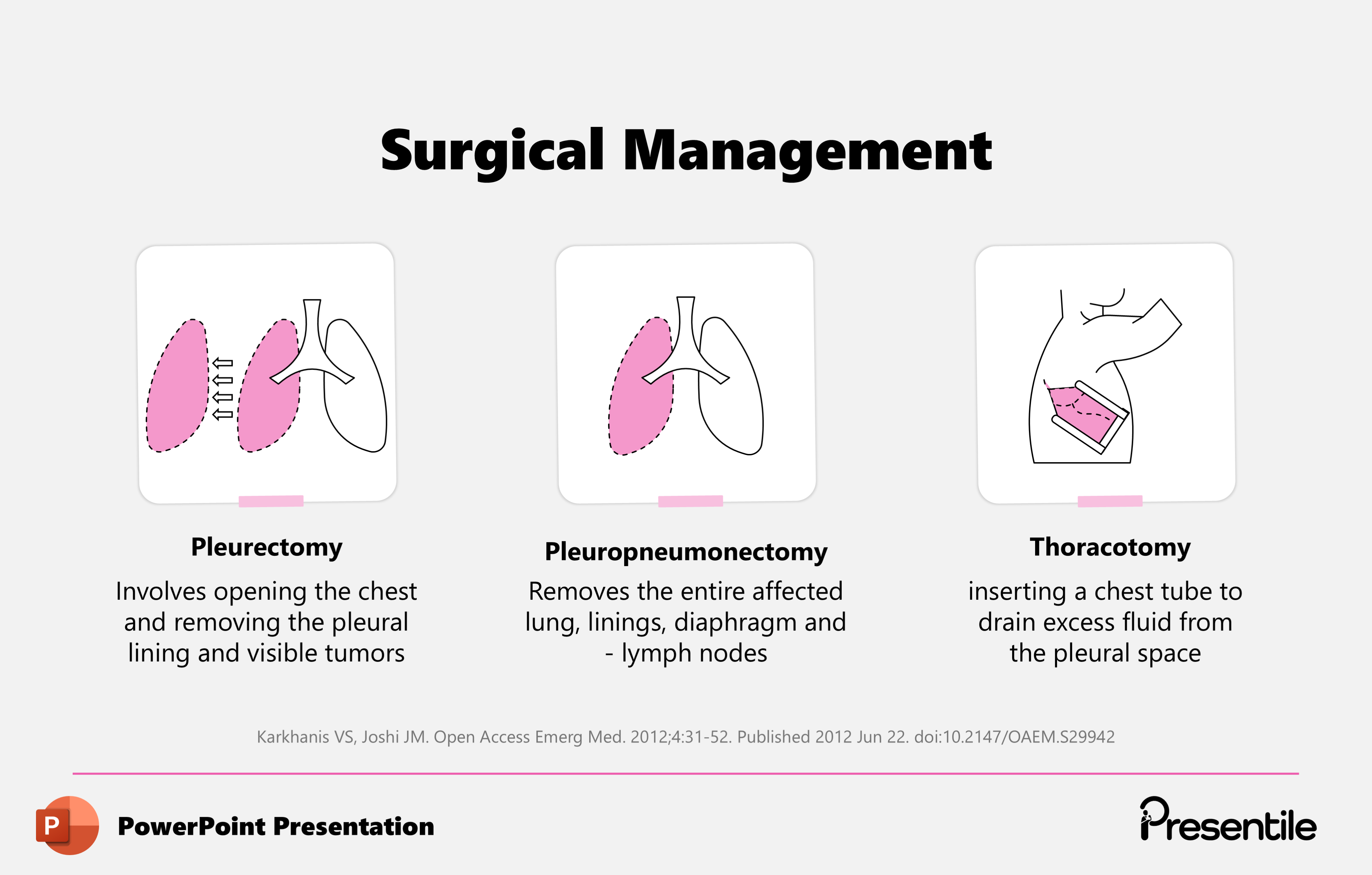
- This slide provides a clear overview of the surgical options for managing pleural effusion.
- It details three key procedures: Pleurectomy, which involves the removal of the pleural lining; Pleuropneumonectomy, which removes the entire lung and its associated tissues; and Thoracotomy, which involves inserting a chest tube for drainage.
- You can use this slide to explain the advanced surgical interventions available, highlighting the different approaches for severe or persistent cases.
Slide 18: Prevention and Risk Reduction

- This slide provides a clear, actionable overview of how to prevent and reduce the risk of pleural effusion.
- You can use this practical guide to explain key lifestyle and dietary changes, such as tobacco avoidance and following a low-salt diet.
- The slide also highlights the clinical use of diuretics and the importance of avoiding asbestos, offering a comprehensive look at both preventative measures and risk mitigation.
Slide 19: Thank You - Conclusion

- This slide serves as a professional and elegant conclusion to the presentation.
- You can use this final slide to gracefully thank your audience for their time and attention while providing a clear visual cue that signals the end of your prepared remarks.
- It’s the perfect way to wrap up the discussion and transition to a question-and-answer session.
Features of
Pleural Effusion Presentation
- Fully editable in PowerPoint
- All graphics are in vector format
- Medically Referenced information and data
Specifications
 Slides count:
Slides count: Compatible with:Microsoft PowerPoint
Compatible with:Microsoft PowerPoint File type:PPTX
File type:PPTX Dimensions:16:9
Dimensions:16:9
Elevate Your Work with Our Innovative Slides
Thank you! Your submission has been received!
Oops! Something went wrong while submitting the form.
No items found.




